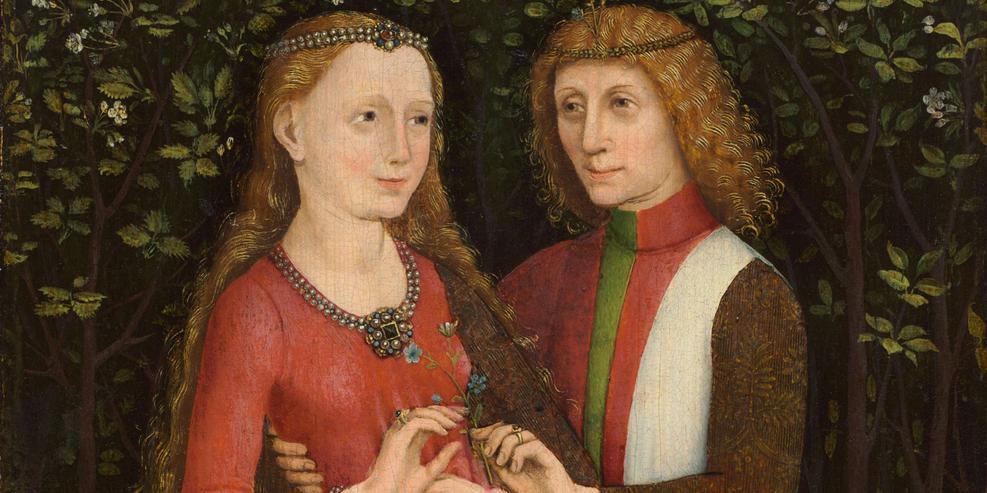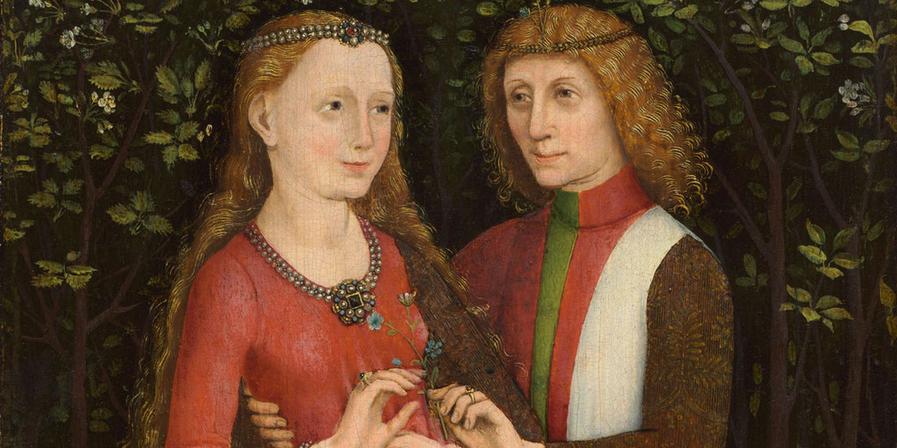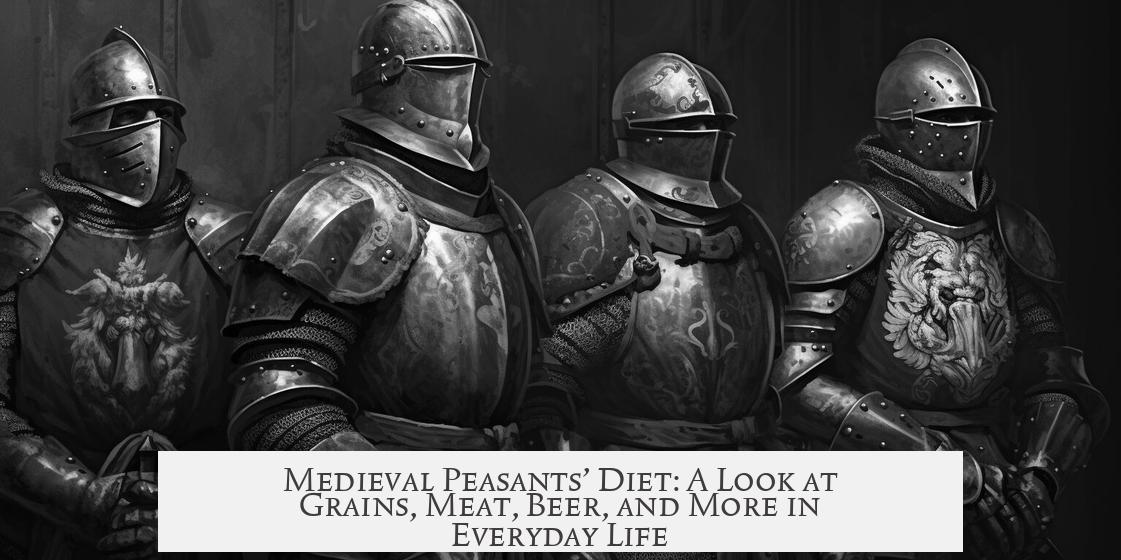Medieval peasants ate a diet largely based on grains, vegetables, and whatever animal or foraged foods were available seasonally. Their meals varied throughout the year depending on crop harvests and what could be gathered or caught. Grains formed the staple, especially in the form of brown bread similar to modern artisan bread, with whiter bread reserved for the wealthier. Bread often accompanied meals, acting as both a utensil and food.

Meat was not daily but was still common. Most peasant households raised a pig that consumed otherwise discarded scraps like spoiled vegetables, fruits, old bread, and bones. These pigs provided pork products such as sausages and blood pudding, often preserved by salting, smoking, or drying. Peasants also ate wild or readily caught game like rabbit and fish, including salmon. Coastal peasants frequently supplemented their diet with fresh fish caught from the sea.
Diets often included pottages and stews—thick soups made by cooking vegetables, grains, and sometimes meats in one pot. Mushy peas were a typical pottage. Some cultures practiced a “perpetual stew,” where leftover foods continuously simmered, enriching flavors over time. Vegetables grown by peasants were mostly cooked in these soups, frequently without meat to stretch food supplies.

Foraged foods such as nuts and chestnuts (marrons) gathered from woods supplemented nutrition. Beer was a common beverage, preferred over water, supplying calories and nutrients essential for keeping energy levels up. The lack of fresh food meant many items were dried, salted, or otherwise preserved whenever possible.
Peasants typically sold their best produce to acquire tools or livestock, relying mostly on simple staples like porridge and cabbage in daily eating. Condiments were limited; an example is saurel sauce—crushed leafy herbs mixed with salt and juices—used for flavoring. Sugar was nearly absent, with honey reserved as a rare, costly sweetener, not part of ordinary fare.

- Grains and brown bread formed the diet’s base.
- Meat came from home-raised pigs and local hunting/fishing.
- Pottages and stews mixed vegetables and sometimes meat.
- Beer was a nutritious staple drink over unsafe water.
- Food was largely preserved due to lack of freshness.
- Simple condiments and rare honey sweetened the meals.
What Did Medieval Peasants Eat? A Closer Look at Their Everyday Plates
Medieval peasants did not dine like kings, but they were far from starving. Their daily meals consisted of seasonal crops, grains, and whatever their land and surroundings offered. Let’s peel back the layers of history and explore the flavors and textures that flavored a peasant’s daily bread—literally.

Their diet was simple but varied across the seasons. When spring burst forth, fresh vegetables sprouted; autumn brought hearty roots and nuts. Peasants ate what was available during each season, showing an early form of “eating local” before it was trendy.
Grains: The Backbone of Their Diet

Grains formed the bulk of the peasant diet. Think of sturdy brown breads—artisan by today’s standards, not the white sandwich bread we toss in lunchboxes. The wealthier one was, the whiter the bread, but peasants’ bread was dense, nutritious, and shared across tables. It wasn’t just a side; it was a staple with every meal.
Bread was often dipped in stews or even used to scoop up food since utensils were a bit of a luxury. This bread wasn’t about fluff or flavor—it was about sustenance that stuck to the ribs.

Meat: Not a Daily Treat, But Not Rare
Contrary to popular belief, meat wasn’t a rare luxury. Peasants often ate pork because most households raised pigs. Pigs were the perfect garbage disposals, happily feasting on everything from spoiled fruits and veggies to old bread and even bones. Nothing went to waste. Sausages and blood pudding were common; the leftovers got smoked, salted, or dried for later use.
Other meats included rabbit, fish, and salmon, especially when peasants lived near rivers or coasts. They were unlikely to have juicy roasts but chopped and fried meat in a pot filled their bellies effectively. Certain times of the year, like religious celebrations, allowed peasants to feast on more meat and fruit—brief windows of culinary luxury mirroring the lords’ tables.
Beer: More Than Just a Drink
Since potable water wasn’t always available or tasty, beer was a daily staple, providing more than just hydration. It added calories and nutrients, crucial in hard labor lifestyles, and tasted better than the swill of questionable water. Imagine slugging a warm, slightly sour but filling beer every day—it’s breakfast, lunch, and dinner in a mug!
Pottages and Stews: The Pot That Never Empties
Pottages, or thick vegetable and grain stews, made up a large part of meals. Peasants threw many ingredients into a pot—vegetables from their gardens, occasionally bits of meat, and whatever else they could forage. A classic dish was mushy peas pottage, simple but filling.
Ever heard of the “perpetual stew”? It was a kind of culinary stew pot that never truly emptied. Leftover food added to the pot day after day, simmering slowly and developing deeper flavors. It was efficient and practical, ensuring no food was wasted.
Foraged Foods: Nuts, Maroons, and Wild Treasures
When pigs and peasants ventured into the woods, nuts like maroons came into their diet. These wild finds supplemented the sometimes-monotonous grains and vegetables. Foraging was vital—peasants understood their land intimately and took advantage of natural offers.
The Coastal Peasant’s Advantages
Coastal peasants lived a slightly different culinary life. Fish, often freshly caught, entered their meals regularly. Salmon, for instance, was common fare. Fishing was a major activity in coastal villages and cities, so these peasants often had more protein variety.
Food Preservation: The Pre-Fridge Challenge
Fresh food was a rarity. Medieval peasants relied heavily on preserving their bounty. Drying, salting, and smoking were essential to survive lean times. We tend to forget how critical preservation was before refrigeration—a splash of salt could mean the difference between a meal and hunger the next month.
Economic Realities: Selling the Best, Saving the Rest
Many peasants lived off staples like porridge and cabbage. The best of their produce wasn’t eaten but sold to buy tools or livestock. It’s a smart system—sell the shine to improve the farm and survive. So the humble cabbage was both on the table and the marketplace.
Condiments and Sweeteners: Saurel Sauce and Honey
Flavors might sound basic, but peasants had their own condiments. English peasants used saurel sauce—a leafy herb pounded with salt, its juices drizzled on meals for a punch of flavor.
Sweetening was another luxury. Sugar didn’t exist as we know it; honey was the precious sweetener. It was expensive and rare, reserved for special occasions. So those sweet flavors we take for granted? Medieval peasants tasted them sparingly.
What Can Modern Foodies Learn from Medieval Peasants?
Thinking about medieval peasants might make us grateful for variety and availability today. But it also invites a fresh appreciation for seasonal eating, preserving food smartly, and minimizing waste. Their diet, though humble, was balanced in its own way—grains for energy, meat when possible, vegetables from gardens and wild areas, and safe hydration by beer.
Next time you eat your artisan bread or sip a craft beer, remember peasants centuries ago who, despite hard lives, made the most of their land and possessions. They managed with grit, creativity, and practical wisdom. What modern diet philosophy could they inspire?
“In the Middle Ages, no food went to waste, and every meal told a story of hard work, community, and ingenuity.”
Curious about the medieval kitchen’s mysteries? Exploring these humble diets offers a fascinating glimpse into how people adapted to their environment and made meals meaningful. Perhaps we, too, can approach eating more thoughtfully—seasonally, sustainably, and with a little dash of creative flavor.




